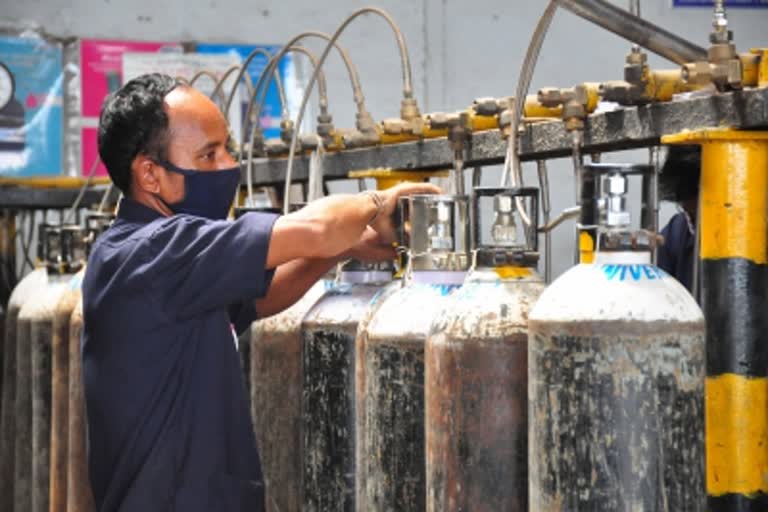New Delhi: Amid a stiffening standoff between various states over the supply of medical oxygen, the Prime Minister and the Ministry of Home Affairs Thursday announced a series of steps to boost production as well as to ease bottlenecks in the movement of oxygen-carrying trucks along state and district borders.
Among the major decisions, the Ministry of Home Affairs has invoked the Disaster Management Act and ordered State and Union Territories to ensure uninterrupted inter-state and intra-state movement of vehicles carrying medical oxygen.
The order also made it clear that the State authorities shouldn’t impose any location-specific restrictions on manufacturers.
“No restrictions shall be imposed on oxygen manufacturers and suppliers to limit the oxygen supplies only to the hospitals of the state and the union territory in which they are located,” said the order.
The Home Ministry has made local officials responsible for any lapses in the implementation of these orders.
“The district magistrates, deputy commissioners and senior superintendents of police, superintendents of police, deputy commissioners of police will be personally liable for the implementation of the above directions.”
PM reviews oxygen production and supply
Chairing a high-level meeting to review oxygen supply across the country, Prime Minister Narendra Modi asked top officials to work rapidly on increasing its production, boosting the speed of distribution and using innovative ways to provide oxygen support to health facilities.
Modi said states should come down heavily on hoarding and stressed the need to ensure faster transportation of oxygen.
Against the present demand from 20 states of 6,785 metric tonnes per day of liquid medical oxygen, the Centre has from April 21 allocated 6,822 metric tonnes to these states, a statement by the Prime Minister’s Office (PMO) said.
The statement also highlighted how the railways are being used for rapid and non-stop long-distance transport of tankers.
The first train under the ‘Oxygen Express’ initiative has reached from Mumbai to Vizag to transport 105 metric tonnes of liquid medical oxygen.
Similarly, empty oxygen tanks are also being air-lifted to oxygen suppliers to reduce one-way journey time in oxygen supply.
More than production, transport is a major problem
Despite high production of oxygen, lack of adequate transportation facilities has accentuated the current medical oxygen crisis, says a top executive of India’s largest liquid oxygen producer.
“Despite high production, the real issue in the availability of liquid medical oxygen (LMO) to hospitals was due to transportation bottlenecks such as limited fleet of cryogenic trucks,” Siddharth Jain, Director, INOX Air Products, told IANS.
Cryogenic trucks are specially designed vehicles to ferry industrial gases in a semi incubated environment.
INOX Air Products is the largest manufacturer of industrial and medical gases in India with a manufacturing capacity of 3,300 tons per day (TPD).
Echoing his views, steel makers Tata Steel and JSPL said logistics-related issues are posing a challenge in the transportation of medical oxygen from steel plants to health facilities.
"We have been supplying 300 tonnes of medical oxygen daily to various states (UP, MP, AP, Jharkhand, Odisha, Bihar and West Bengal) and hospitals. We stand ready to increase the supply though currently there is a shortage of containers and trailors to carry and transport the oxygen," a Tata Steel spokesperson said.
JSPL MD V R Sharma also said logistics remains an issue in the transportation of medical oxygen from steel plants.
He said tankers are unavailable, and added there is a need to track the number of tankers in the country so that they can be assigned the task of transporting oxygen.
The demand for liquid medical oxygen had jumped from a pre-
Covid level of 700 TPD to 2,800 TPD during the first wave of Covid-19 infections last year.
With the resurgence of the second wave, the demand has gone up many folds of the pre-Covid levels to about 6,000 TPD.
Hospitals across India, especially in Maharashtra, Madhya Pradesh and Gujarat, have been grappling with oxygen shortages due to an unprecedented spike in Covid-19 cases.
While there is no official statement so far whether lack of oxygen has caused the death of any Covid-19 patient, reports show that an acute shortage of life-saving gas has resulted in many deaths in the last week.
(With Agency Inputs)



